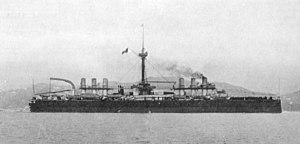Italia-class battleship

|
|
| Class overview | |
|---|---|
| Name: | Italia class |
| Operators: |
|
| Preceded by: | Caio Duilio class |
| Succeeded by: | Ruggiero di Lauria class |
| Built: | 1876–1887 |
| In service: | 1885–1921 |
| Completed: | 2 |
| Retired: | 2 |
| General characteristics | |
| Type: | ironclad battleship |
| Displacement: |
|
| Beam: | 22.54 m (74.0 ft) |
| Draft: | 8.75 m (28.7 ft) |
| Installed power: |
|
| Propulsion: | 4 shafts, 4 compound engines |
| Speed: | 17.8 knots (33.0 km/h; 20.5 mph) |
| Range: | ca. 5,000 nautical miles (9,260 km) at 10 knots (19 km/h; 12 mph) |
| Complement: | 669–701 |
| Armament: |
|
| Armor: |
|
The Italia class was a class of two ironclad battleships built for the Italian Regia Marina (Royal Navy) in the 1870s and 1880s. The two ships—Italia and Lepanto—were designed by Benedetto Brin, who chose to discard traditional belt armor entirely, relying on a combination of very high speed and extensive internal subdivision to protect the ships. This, along with their armament of very large 17-inch (430 mm) guns, has led some naval historians to refer to the Italia class as prototypical battlecruisers.
Despite serving for over thirty years, the ships had uneventful careers. They spent their first two decades in service with the Active and Reserve Squadrons, where they were primarily occupied with training maneuvers. Lepanto was converted into a training ship in 1902 and Italia was significantly modernized in 1905–08 before also becoming a training ship. They briefly saw action during the Italo-Turkish War, where they provided gunfire support to Italian troops defending Tripoli. Lepanto was discarded in early 1915, though Italia continued on as a guard ship during World War I, eventually being converted into a grain transport. She was ultimately broken up for scrap in 1921.
Starting in the 1870s, following the Italian fleet's defeat at the Battle of Lissa, the Italians began a large naval expansion program, at first aimed at countering the Austro-Hungarian Navy. The Italias were the second class of the programme, which also included the Caio Duilio, designed in the mid-1870s by Insp Eng Benedetto Brin. The ships were authorized in 1875, with funding allocated to begin construction the following year. They were faster and more seaworthy than the preceding Caio Duilio class, owing to their higher freeboard. Brin intended them to be capable of fighting successfully against any foreign warship in service, and so he opted for very large guns for the main battery.
...
Wikipedia
